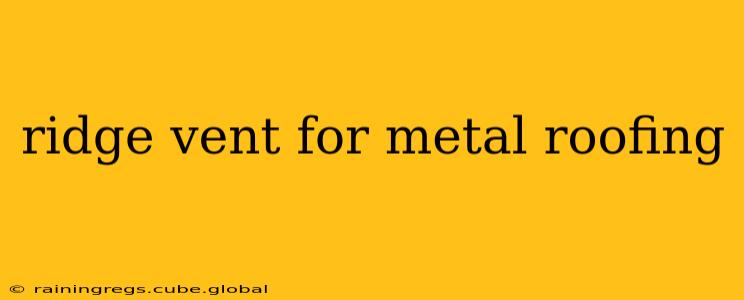Metal roofing is a popular choice for its durability and longevity. However, proper ventilation is crucial to prevent moisture buildup and extend the life of your roof. A ridge vent is a key component of this ventilation system, playing a vital role in maintaining a healthy and long-lasting roof. This guide will delve into the importance of ridge vents for metal roofing, addressing common questions and concerns.
What is a Ridge Vent and How Does it Work?
A ridge vent is a continuous vent installed along the peak (ridge) of your roof. Unlike individual vents, it allows for even airflow across the entire roofline. It works in conjunction with soffit vents (located at the eaves) to create a natural convection current. Hot, moist air rises from the attic space and escapes through the ridge vent, while cooler, drier air enters through the soffit vents, creating a continuous flow of air that prevents moisture accumulation.
Why is a Ridge Vent Important for Metal Roofing?
Metal roofs are incredibly durable but are particularly susceptible to moisture damage if not properly ventilated. The heat from the sun can significantly increase the temperature inside the attic, leading to:
- Moisture buildup: Warm, moist air can condense on the cooler surfaces of the roof deck and framing, leading to mold, mildew, and rot.
- Ice dam formation: In colder climates, trapped moisture can freeze and thaw, creating ice dams that can damage roofing materials and gutters.
- Reduced energy efficiency: A poorly ventilated attic can significantly reduce the efficiency of your home's HVAC system, leading to higher energy bills.
- Shorter lifespan of roofing materials: Moisture damage can weaken the structural integrity of your roof, leading to premature failure and costly repairs.
What are the Different Types of Ridge Vents for Metal Roofing?
Several types of ridge vents are compatible with metal roofing:
- Pre-fabricated ridge vents: These are factory-made units that are easily installed and offer a streamlined appearance.
- Continuous ridge vents: These vents run the entire length of the ridge and provide maximum ventilation. They are often customized to fit the specific dimensions of the roof.
- Custom-fabricated ridge vents: These vents are tailored to match the specific design and aesthetics of your metal roof.
How Much Ventilation Do I Need for My Metal Roof?
The amount of ventilation you need depends on several factors, including:
- Climate: Hotter, more humid climates require more ventilation.
- Attic size: Larger attics require more ventilation.
- Insulation levels: Proper insulation helps reduce heat transfer to the attic, reducing the need for excessive ventilation.
It's best to consult with a qualified roofing professional to determine the optimal ventilation rate for your specific situation. They can perform a ventilation calculation to ensure proper airflow.
Can I Install a Ridge Vent Myself?
While some DIY-ers attempt ridge vent installation, it's generally recommended to hire a professional roofer. Improper installation can compromise the effectiveness of the ventilation system and lead to future problems. A professional will ensure proper sealing and integration with your metal roofing system.
What are the Costs Associated with Installing a Ridge Vent?
The cost of installing a ridge vent varies depending on the size of your roof, the type of vent chosen, and labor costs in your area. It's essential to obtain multiple quotes from reputable roofing contractors before making a decision.
How Long Does a Ridge Vent Last?
The lifespan of a ridge vent is typically comparable to the lifespan of the metal roofing itself, often lasting 20-50 years or more with proper maintenance.
How Often Should I Clean My Ridge Vent?
Regular cleaning is important to maintain the efficiency of your ridge vent. Debris, such as leaves and twigs, can accumulate and restrict airflow. It's recommended to clean your ridge vent at least once a year, more frequently if necessary, depending on your location and environmental conditions.
By understanding the importance of ridge vents and addressing potential issues proactively, you can ensure the longevity and performance of your metal roof, safeguarding your home from costly repairs and potential damage. Remember to consult with a qualified roofing professional for accurate assessments and expert installation.
